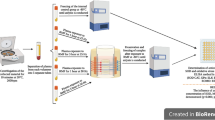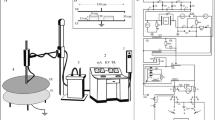Abstract
Objective
The purpose of this study was to determine a possible relation between exposure to extremely low frequency magnetic field (ELF-MF) and the human antioxidant activity.
Methods
The total serum antioxidant status (TAS), red blood cells (RBCs) glutathione peroxidase (GPX) and superoxide dismutase (SOD) were measured in 46 spot welders who were occupationally exposed to ELF-MF (magnetic field strength = 8.8–84 microTesla (μT), frequency = 50 Hertz (Hz) and electric field strength = 20–133 V/m). The results were compared with a nonexposed ELF-MF control group. The correlation between magnetic field strength and antioxidant activity in RBCs and plasma was then assessed.
Results
No significant differences in TAS levels were observed (P value = 0.065). However, in RBCs of exposed group, a significant decrease in SOD and GPX activities was observed (P value = 0.001 and 0.003, respectively). This decrease was measured as 22 and 12.3%, respectively. Furthermore, a significant negative correlation between SOD/GPX activities and magnetic field intensity was observed (coefficients of SOD: −0.625, significance: 0.0001 and coefficients of GPX: −0.348, significance: 0.018).
Conclusion
The results of this study indicate that ELF-MF could influence the RBC antioxidant activity and might act as an oxidative stressor. Intracellular antioxidant enzymes such as SOD and GPX were found to be the most important markers involving in this process. The influence of magnetic field on the antioxidant activity of RBCs might occur even at the recommended levels of exposure.






Similar content being viewed by others
References
Block G, Dietrich M, Norkus E, Jensen C, Benowitz N, Morrow J et al (2006) Intraindividual variability of plasma antioxidants, markers of oxidative stress, C-reactive protein, cotinine, and other biomarkers. Epidemiology 17(4):404–412. doi:10.1097/01.ede.0000220655.53323.e9
Chen G, Upham BL, Sun W, Cang CC, Rotwall EJ, Chen KM (2000) Effect of electromagnetic field exposure on chemically induced differentiation of friend erythroleukemia cells. Environ Health Perspect 108(10):967–972. doi:10.2307/3435056
Di Carlo A, White N, Guo F, Garrett P, Litovitz T (2002) Chronic electromagnetic field exposure decreases HSP70 levels and lowers cytoprotection. J Cell Biochem 84(3):447–454. doi:10.1002/jcb.10036
Frahm J, Lantow M, Lupke M, Weiss DG, Simkó M (2006) Alteration in cellular functions in mouse macrophages after exposure to 50 Hz magnetic fields. J Cell Biochem 99(1):168–177
International Commission on Non-Ionizing Radiation Protection (ICNIRP) (1998) Guidelines for limiting exposure to time-varying electric, magnetic, and electromagnetic fields (up to 300 GHz). Health Phys 74:494–522
Ivancsits S, Diem E, Pilger A, Rudiger HW, John O (2002) Induction of DNA strand breaks by intermittent exposure to extremely-low-frequency electromagnetic fields in human diploid fibroblasts. Mutat Res 519(1/2):1–13
Kheifets L, Repacholi M, Saunders R, Van Devanter E (2005) The sensitivity of children to electromagnetic fields. Pediatrics 116(2):e303–e313. doi:10.1542/peds.2004–2541
Kheifets L, Shimkhada R (2005) Childhood leukemia and EMF: review of the epidemiologic evidence. Bioelectromagnetics 7:S51–S59. doi:10.1002/bem.20139
McKinney PA (2005) Central nervous system tumours in children: epidemiology and risk factors. Bioelectromagnetics 7:S60–S68
Kula B, Sohczak A, Kuskar (2002) Effect of electromagnetic field on free radical processes in steel workers. Part I: magnetic field influence on the Antioxidant Activity in red blood cells and plasma. J Occup Health 44:226–229. doi:10.1539/joh.44.226
Lagorio S, Salvan N (2001) Infantile leukemia and exposure to 50/60 Hz magnetic fields: review of epidemiologic evidence in 2000. Ann Ist Super Sanita 37(2):213–224
Lee BC, Johng HM, Lim JK, Jeong JH, Baik KY, Nam TJ, Lee JH, Kim J, Sohn UD, Yoon G, Shin S, Soh KS (2004) Effects of extremely low frequency magnetic field on the antioxidant defense system in mouse brain: a chemiluminescence study. J Photochem Photobiol B 73(1/2):43–48
Luo JC, Hsu KH, Shen WS (2006) Pulmonary function abnormalities and airway irritation symptoms of metal fumes exposure on automobile spot welders. Am J Ind Med 49(6):407–416. doi:10.1002/ajim.20320
Scassellati SG, Moretti M, Fatigoni C, Pasquini R (2004) Evaluation of genotoxic and/or co-genotoxic effects in cells exposed in vitro to extremely-low frequency electromagnetic fields. Ann Ig 16(1/2):321–340
Simkó M, Mattsson MO (2004) Extremely low frequency electromagnetic fields as effectors of cellular responses in vitro: possible immune cell activation. J Cell Biochem 93(1):83–92
Sohczak A, Kula B, Kuska R (2002) Effect of electromagnetic field on free radical processes in steel workers. Part II: magnetic field influence on Vitamin A, E, and selenium concentration in plasma. J Occup Health 44:230–233. doi:10.1539/joh.44.230
Strasak L, Vettrel V, Smarda J (2002) Effect of low frequency magnetic field on bacteria Escherichia coli. Bioelectrochemistry 55:161–164
Winker R, Ivancsits S, Pilger A, Adlkofer F, Rudiger HW (2005) Chromosomal damage in human diploid fibroblasts by intermittent exposure to extremely low-frequency electromagnetic fields. Mutat Res 585(1/2):43–9
Wolf FI, Torello A, Tedesco B, Fasanella S, Boninsegna A, D’Ascenzo M (2005) 50 HZ ELF EMF enhance cell proliferation and DNA damage; possible involvement of redox system. Biochem Biophys Acta 1743:120–129
Yokus B, cakir DU, Akdag MZ, Sert C, Mete N (2005) Oxidative DNA damage in rats exposed to ELF magnetic field. Free Radic Res 39(3):317–323
Acknowledgments
We would like to thank Tehran University of Medical Sciences in Iran for providing the financial support for this study. We also would like to thank the SAIPA Car Company in Iran, especially Mr. Rahimi, Mr. Hesamian and Mr Hoorzad, the managers of occupational health at this company, for assisting us in performing this research on their workers. Finally, we would like to thank Dr. Z. Chiti who linguistically revised our manuscript.
Author information
Authors and Affiliations
Corresponding author
Rights and permissions
About this article
Cite this article
Sharifian, A., Gharavi, M., Pasalar, P. et al. Effect of extremely low frequency magnetic field on antioxidant activity in plasma and red blood cells in spot welders. Int Arch Occup Environ Health 82, 259–266 (2009). https://doi.org/10.1007/s00420-008-0332-2
Received:
Accepted:
Published:
Issue Date:
DOI: https://doi.org/10.1007/s00420-008-0332-2




